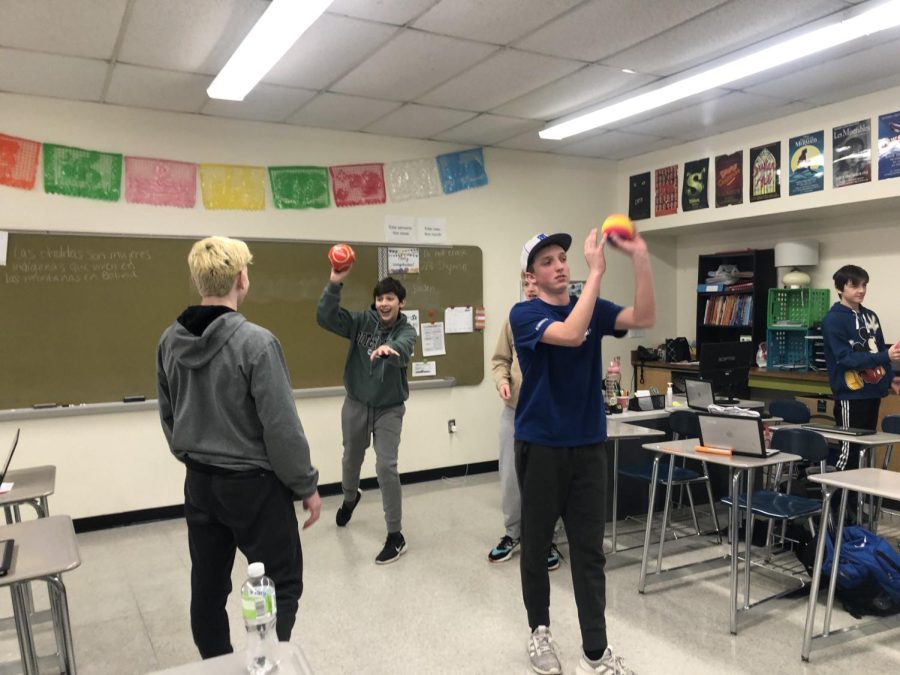High Schoolers Need to Have Brain Breaks
Students toss a ball to each other in Srta. Swartz’ class during one of the regular brain breaks.
With 45 minutes still left in the block, your eyes begin to feel heavy, you lose concentration, and you become increasingly confused as the class drags on. Your attention drifts as you become more lost, and count down the minutes until you can finally walk out the door and escape the overwhelming overload of information.
As sleep-deprived students aimlessly drift away from class engagement, their focus and motivation decrease. Our brains aren’t retaining the information properly, and many students tend to feel burnt out by the time the bell rings. As such, having small breaks throughout a class period can influence the academic performance of many high school students.
Incorporating “brain breaks” in a block can ease the rollercoaster of emotions that most students have to endure throughout the school day, such as stress, anxiety, and frustration. In addition, optimal productivity, attention, and memory can be achieved after just a few minutes away from attentive listening or tedious note-taking.
“Sometimes in class, when I’m taking a lot of notes, I get really tired, and I can’t focus anymore, and I feel really unmotivated,” said sophomore Alex Lea. “I feel like just giving students five-minute breaks periodically would be helpful and help them retain more information and become more engaged in the classroom.”
Running on only a few hours of sleep due to being pulled in a million different directions throughout the day, rarely taking any mental breaks poses a detriment to students’ academic potential as their brains lack ideal stimulation.
High school Spanish teacher Ms. Jessica Swartz does brain breaks regularly with her students, and she has seen positive results.
“I definitely would recommend it,” she said. “I think you lose a little bit of instructional time, but you gain so much in the students’ focus and motivation.”
Some teachers may feel that breaks dispersed throughout a class period could potentially disrupt the teaching of material and conflict with lesson plans. Although the issue could be a problem depending on a class’s structure, in the long run, the brain breaks would boost students’ involvement and revive their attention and memory, leading to noticeable results such as greater participation and improved performance on tests.
“[The] majority of the teachers could support it if they can work it in as they see fit,” science teacher Mr. Rick Dreves said. “It can’t be like ‘every 20 minutes we have to stop,’ because maybe the assignment needs to be 30 minutes, and then stop.”
Simply stretching, moving around the classroom, listening to music, taking a nap, or interacting with peers can reinvigorate our brains to restore concentration and have an ideal emotional and mental state. Sitting through heavy informational or instructional material and class discussion for up to an hour spirals students into disengagement from the class. Quick breaks can be critical for the betterment of students’ ability to retain the material.
“On my quarter reflections…the number one thing that students say helps them focus in class is knowing that they are going to have a brain break,” Ms. Swartz said.
With each class block being almost an hour and a half, there should be enough time for at least one or two five-minute breaks for the benefit of the students and possibly even the teachers, who may appreciate the time to prepare for what comes next. Students’ mental health is an essential factor that plays a crucial role in their academic performance, so teachers should take it into account.
The human brain is the most complex organ in the body and requires mobilizing its various networks after undergoing high-intensity work. Research has shown that the attention span of teenagers and adults has dropped to 20, 10, or even 5 minutes. According to a 2012 Pew Research study, 87% of teachers say that internet and digital search tools are creating an “easily distracted generation with short attention spans.”
“Attention has gotten shorter over the years,” Mr. Dreves said, “so chunks with breaks in the middle would alleviate some of the stress of losing focus.”
Staring at a computer screen for a long period of time while doing lengthy assignments in class is unhealthy for both the eyes and the brain. Instilling brain breaks can facilitate more productivity in the presence of a screen.
Neurotransmitters, brain chemicals that carry messages from one nerve cell to the next, are necessary to maintain a calm mood, focused attention, and good memory. However, if continuing the same learning activity for an extended period, neurotransmitters can deplete after only 10 minutes.
“I just notice when students’ focus and energy starts to drain, I get up and do a brain break and we are back to normal,” Ms. Swartz said.
Whether the breaks involve physical movement or mindfulness exercises, the downtime has numerous benefits for students, including a flow of greater creativity, making fewer errors, and feeling more motivated to get assignments done. It’s important to recognize that a minor change could significantly transform student success.

Sophomore Elizabeth Vezenov is a first-year staff reporter for the Spotlight. She also participates in Teen Counseling, MiniTHON, Varsity Club, and Yearbook....


